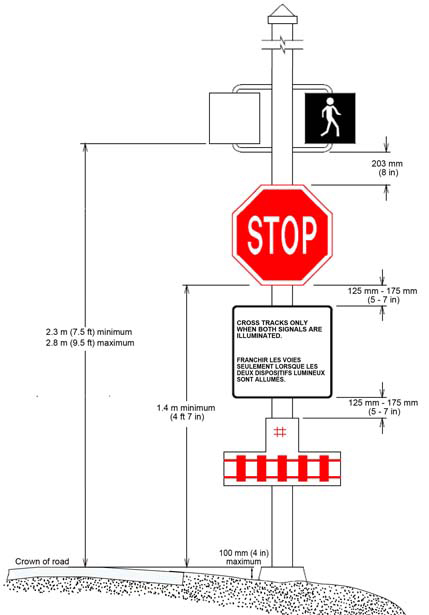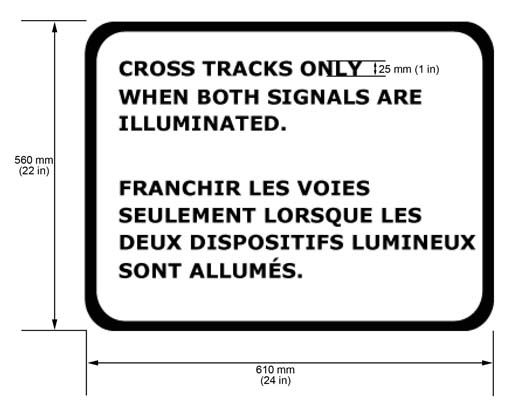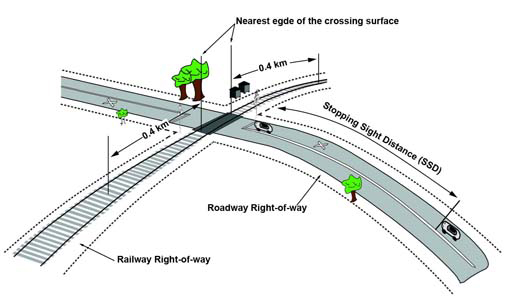- Appendix A - Light Emitting Diode (LED) Signal Modules
- Appendix B - Limited Use Warning Systems and Signs
- Appendix C - Limited Use Warning Systems with Walk Light
- Appendix D - Whistling Cessation
Appendix A – Light Emitting Diode (LED) Signal Modules
Standards for LED Signal Modules in Warning Systems
1. Definitions
Candela (cd) – SI unit of luminous intensity. The candela is the luminous intensity, in a given direction, of a source that emits monochromatic radiation of frequency 540 nm and that has a radiant intensity in that direction of 1/683 W per steradian (1 cd = 1 lm/sr).
Lumen (lm) – SI unit of luminous flux. Luminous flux emitted in unit solid angle [steradian (sr)] by a uniform point source having a luminous intensity of 1 candela (1 lm = 1 cd x 1 sr).
Luminance Lv (in a given direction, at a given point on a real or imaginary surface) – quantity defined by the formula:
Lv = dΦv / dA • dΩ • cosθ
where dΦv is the luminous flux transmitted by an elementary beam passing through the given point and propagating in the solid angle dΩ containing the given direction; dA is the area of a section of that beam containing the given point; θ is the angle between the normal to that section and the direction of the beam (footlambert, cd/m2).
Luminous Efficacy of Radiation (K) – the luminous flux Φv divided by the corresponding radiant flux Φe
(K = Φv/Φe).
Luminous Intensity (Iv) (of a source in a given direction) – the luminous flux dΦv leaving the source and propagating in the element of solid angle dΩ containing the given direction, divided by the element of solid angle (Iv = dΦv / dΩ candela).
Luminous Flux (Φv) – quantity derived from radiant flux Φe by evaluating the radiation according to its action upon the CIE standard photometric observer (lumen).
Rated Voltage – the nominal or design operating voltage of the LED signal module; the voltage at which rated watts, candelas, and life are determined.
Rated Watts – the average initial power (watts) consumed when the lamp is operated at rated voltage.
2. Photometric Requirements
2.1 Luminous Intensity
When LED signal modules are in use at a warning system, they must meet the minimum luminous intensity values shown in Table A-1.
Table A-1 – Minimum Luminous Intensity (Candela) over Temperature and Lifetime
| 0° | 5°Left (L)/Right (R) | 10°L/R | 15°L/R | 20°L/R | 25°L/R | 30°L/R | |
|---|---|---|---|---|---|---|---|
| 0° | 400 | 375 | 250 | 150 | 75 | 40 | 15 |
| 5°Down (D) | 350 | 325 | 250 | 150 | 75 | 40 | 15 |
| 10°D | 130 | 125 | 110 | 85 | 60 | 35 | 15 |
| 15°D | 45 | 40 | 35 | 30 | 25 | 20 | 15 |
| 20°D | 15 | 15 | 15 | 15 | 15 | 15 | 10 |
2.2 Chromaticity
A signal module must produce a uniform red light output as specified in article 4.2 of the Vehicle Traffic Control Signal Heads – Light Emitting Diode Circular Supplement, published by the Institute of Transportation Engineers, dated June 2005.
2.3 Uniformity
The ratio of the greatest and least luminance on the signal module must not be more than 5:1, when measured over average areas of 500 mm2.
2.4 Rise/Fall Time
The maximum rise time from zero intensity to full intensity, and the maximum fall time from full intensity to zero intensity, must be 75 ms.
3. Physical and Mechanical Requirements
3.1 LED Signal Module Design
3.1.1 The LED signal module must be designed to fit the grade crossing light unit housings, described in Part 3.2.35 of the AREMA Communications and Signals Manual (cited in Part A), without requiring modification of the mechanical, structural, or electrical components.
3.1.2 The LED signal module must be either 200 mm or 300 mm in size.
3.1.3 The LED signal module must have either a clear or a red lens.
3.1.4 Any gasket or similar sealing provisions must be made of a material as specified in Part 15.2.10 of the AREMA Communications and Signals Manual (cited in Part A).
3.2 Environmental Requirements
3.2.1 The LED signal module must operate over an ambient temperature range of -40°C (-40°F) to 70°C (158°F) in accordance with sections 1 to 3 of the "Method 1010.8 Temperature Cycling", dated June 18, 2004 of MIL-STD-883H, Test Method Standard, Microcircuits, published by the United States Department of Defence, dated February 26, 2010 and must satisfy the failure criteria set-out in article 3.3 of that standard, and any reference to end-point measurements and examinations are to be read as those provided by the supplier.
3.2.2 The LED signal module must be protected against dust and moisture intrusion in a Type 4 enclosure in a manner that meets the requirement of article 8.6.2 of the Canadian Standards Association standard CAN/CSA-C22.2 No. 94.2-07 entitled Enclosures for Electrical Equipment, Environmental Considerations, as amended from time to time, when tested in accordance with article 8.6.1 of that Standard.
3.2.3 The LED signal module must meet mechanical vibration and shock requirements as specified in Part 11.5.1 of the AREMA Communications and Signals Manual (cited in Part A).
3.2.4 The LED signal module lens must be UV stabilized.
3.3 Identification
3.3.1 The LED signal module must have a label containing the following information:
- the LED colour;
- the beam deflection classification;
- the operating voltage;
- the current consumption at operating voltage;
- the module’s serial number; and
- the date of manufacture.
3.3.2 If the module or its components require orientation, they must be prominently and permanently marked with an indexing arrow.
4 Electrical Requirements
4.1 Transient Voltage Protection
LED signal module circuitry must include voltage surge protection as specified in Part 11.3.3 of AREMA Communications and Signals Manual (cited in Part A).
4.2 LED Drive Circuitry
LED signal module circuitry must operate as specified in Part 3.2.35 of the AREMA Communications and Signals Manual (cited in Part A).
4.3 Dielectric and Electromagnetic Interference
LED signal module circuitry must conform to dielectric and electromagnetic interference requirements for Class B equipment in Part 11.5.1 of AREMA Communications and Signals Manual (cited in Part A).
Appendix B – Limited Use Warning Systems and Signs
1. Operating Requirements
1.1 Battery backup for a minimum of 24 hours of normal railway operations must be provided.
1.2 Power monitor lights must be provided.
2. Warning System Requirements
2.1 Limited Use Warning System must meet the specifications of articles 12 to 16 of the Grade Crossings Standards (GCS) except:
- it does not require a gate.
- height of the light unit may be different than that stated in the AREMA Communications and Signals Manual (cited in Part A) or the GCS (cited in Part A) as to improve conspicuity:
- Signal mast may be located closer to the road approach than that stated in the AREMA Communications and Signals Manual (cited in Part A) or the GCS (cited in Part A) improve conspicuity.
- A bell is not required; and
- Front and back lights must be provided on each warning signal assembly.
3. Signage Requirements
3.1 An Emergency Notification sign must be installed at each location.
3.2 A sign indicating that the road is private must be posted near the entrance to the private road.
Appendix C - Limited Use Warning System with Walk Light
Operating Requirements
1.1 Battery backup of a minimum of 8 hours must be provided.
1.2 Power monitor lights must be provided.
Signal Requirements
1.3 A Limited Use Warning System with Walk Light must meet the specifications below:
- must be installed on each side of the grade crossing and face a crossing user approaching the grade crossing;
- must include a signal head that displays a signal indicating to a crossing user that it is safe to proceed when railway equipment is not approaching. This signal head must be extinguished when railway equipment is approaching;
- The signal head must be as specified in sections 2 to 5, excluding the last paragraph of section 4.1.1, of the ITE “Pedestrian Traffic Control Signal Indications - Part 2: Light Emitting Diode (LED) Pedestrian Traffic Signal Modules” prepared by the Joint Industry and Traffic Engineering Council Committee, published by the Institute of Transportation Engineers, dated March 19, 2004, except for the following aspects:
- 12VDC pedestrian module is to be used instead of a 120VAC input voltage;
- the operating voltage range must be 9 – 15VDC, and the light must shut off at 7.3VDC or less; and
- References to “LED Pedestrian Signal Module” or “Module” are to be read as “Walk Light”.
- The walk light indicating that it is safe to proceed must be extinguished a minimum of 20 seconds plus the clearance time before the arrival of railway equipment at the crossing surface.
- The clearance time must be based on design vehicle and must be calculated in accordance with article 10 of the GCS (cited in Part A).
Signage and Post Requirements
1.4 Signage indicating how to use the Limited Use Warning Systems with Walk Light as illustrated in Figure C-2 and must:
- be mounted on the mast under the walk light signal head as indicated in Figure C-1; and
- have a silver background that is reflective with silk screened black or vinyl lettering. Where required by law, the word “Arrêt” may replace the word “Stop”, or may be added to the Stop Sign.
1.5 A Stop sign must be as shown in article A2.2.1 of the Manual of Uniform Traffic Control Devices for Canada (cited in Part A) and must meet the applicable specifications A1.6 of that Manual. Where required by law, the word “Arrêt” will replace the word “Stop”, or may be added to the Stop sign. The Stop sign must be mounted on the mast as shown in Figure C-1.
1.6 An Emergency Notification sign must be located at each Limited Use Warning System with Walk Light Assembly.
Figure C-1 - Text version
Front view the assembly of a limited use warning system with Walk Light with dimensions
The bottom edge of the walk light is between 2.3 and 2.8 m from the crown of the road.
The distance between the top of the assembly foundation and the surrounding ground level is 100 mm maximum.
The bottom edge of the stop sign is at a minimum 1.4 m from the crown of the road.
Distance between top edge of stop sign and bottom walk light anchor is 203 mm.
Distance between the bottom edge of the stop sign and the upper edge of the "cross tracks only when both signals are illuminated" sign is between 125 and 175 mm.
Distance between the bottom edge of the "cross tracks only when both signals are illuminated" sign and the upper edge of the Number of Tracks sign is between 125 and 175 mm
Figure C-2 - Text version
An example and dimensions of an Instruction Sign which is a rectangular-shaped sign that reads "Cross tracks only when both signals are illuminated."
The height of the sign is 560 mm and the width is 610 mm and the font size of the text is 25 mm.
Appendix D – Whistling Cessation
| Column A | Column B | |||
|---|---|---|---|---|
| Railway Design Speed | Grade Crossings for Vehicle Use | Grade Crossings For Sidewalks, Paths, or Trails with the centreline no closer than 3.6 m (12 ft) to a warning signal for vehicles | ||
| No. of Tracks | No. of Tracks | |||
| 1 | 2 or more | 1 | 2 or more | |
| Column 1 | Column 2 | Column 3 | Column 4 | Column 5 |
| 1 – 25 km/h (15 mph) | FLB | FLB | No warning system requirement | No warning system requirements |
| 25 – 81 km/h
(16 – 50 mph) |
FLB | FLB & G | FLB | FLB & G |
| Over 81 km/h (50 mph) | FLB & G | FLB & G | FLB & G | FLB & G |
Legend :
FLB is a warning system consisting of flashing lights and a bell.
FLB & G is a warning system consisting of flashing lights, a bell and gates.
Figure D-1 - Text version
An overhead view of a grade crossing illustrating the prescribed area for whistling cessation as per article 23.1 of the Railway Safety Act.
As provided for in section 99(1)(i) of the regulations the area within the railway right-of-way, is on each side of the public grade crossing, and within 0.4 km from the outer edge of the crossing surface.


